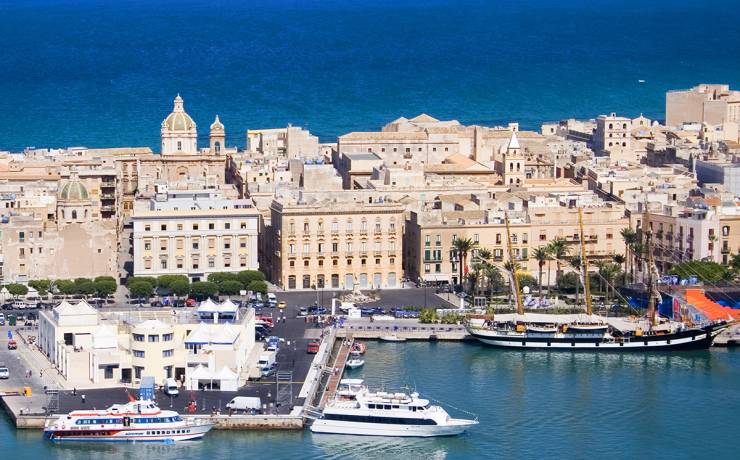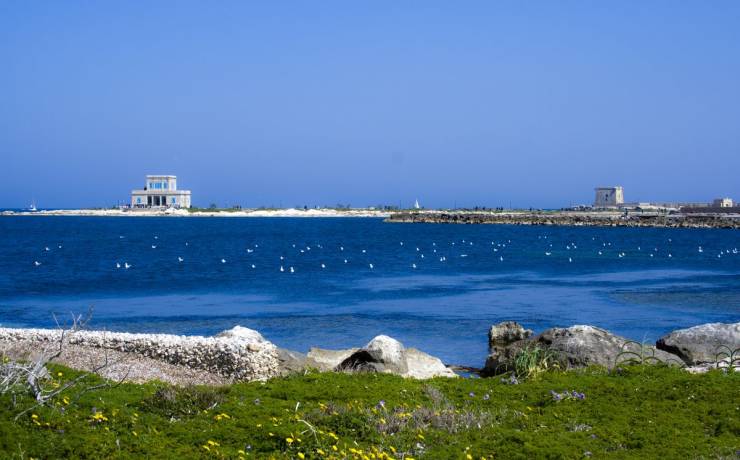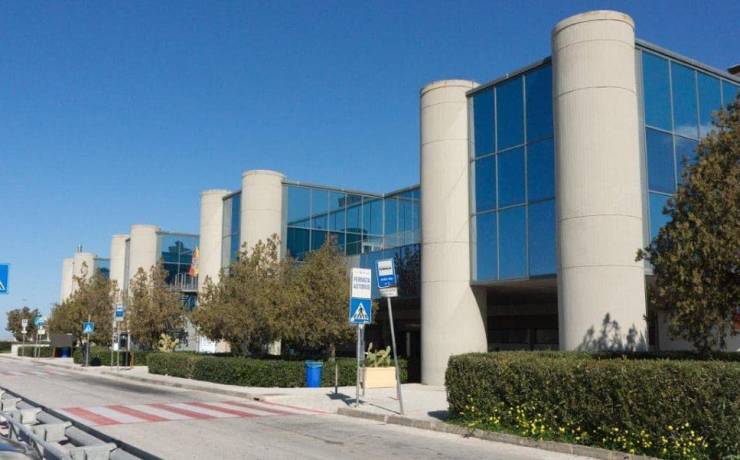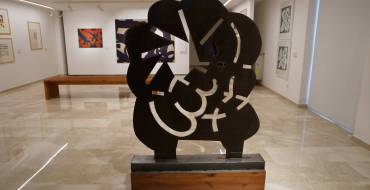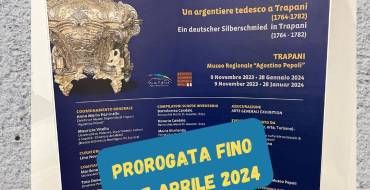Trapani Welcome
Trapani e Provincia – hotel, agriturismo, casa-vacanze, B & B, affittacamere, campeggi
Trapani, città dalle tante facce, dai mille sapori. Città di mare, viva e laboriosa. Benvenuti a Trapani, capoluogo della provincia più occidentale della Sicilia.
Trapani è un vivace centro culturale, ricco di spiagge, attrazioni, musei, ideale per un viaggio in compagnia o con la famiglia. Non solo fede e folclore: oggi Trapani unisce appuntamenti imperdibili come la tradizionale “Processione dei Misteri” del Venerdì Santo, a eventi mondani, culinari e sportivi. Visitando la città, vi renderete conto come a Trapani convivono tradizioni millenarie, come la coltivazione del sale e la lavorazione del corallo in un contesto dinamico ed effervescente.
Questo portale, nasce proprio per entrare in contatto con Trapani, viverla, conoscerla. Sarà una vostra utile e pratica compagna di viaggio. Al suo interno troverete gli itinerari suggeriti, i percorsi tra piazze e monumenti, le dritte su locali, su come muoversi e sulle cose da fare e da vedere.
Dove Dormire
Dove Dormire Categorie Affittacamere Agriturismo Alcamo Altro B&B Buseto Palizzolo Calatafimi Segesta Campobello di Mazara Case per ferie Case Vacanza Castellamare del Golfo Castelvetrano Custonaci Dammusi Erice Favignana Gibellina Hotel Marsala Mazara del Vallo Misiliscemi Ostelli Paceco Pantelleria Partanna Petrosino Poggioreale Residence Resort RTA Salaparuta Salemi San Vito Lo Capo Santa Ninfa Trapani Valderice Villaggio turistico Vita Cerca Chiavi di ricerca popolari Categorie Nessun risultato Mostra tutti i risultati Filtra per luogo TutteTrapaniEriceFavignanaSan Vito Lo CapoMarsalaPetrosinoMazara del ValloCustonaciBuseto PalizzoloValdericePantelleriaCastellamare del GolfoCalatafimi SegestaSalemiCastelvetranoCampobello di MazaraAlcamoGibellinaMisiliscemiPacecoPartannaPoggiorealeSalaparutaSanta NinfaVita AgriturismoCastelvetrano(Azienda agricola Latomie Torres) Agriturismo Case Sgaraglino Case VacanzaTrapani32 venti Case VacanzaCastellamare del Golfo4 Canti Case vacanze B&BCampobello di Mazara4 Stagioni B&BSan Vito Lo Capo5 Girasoli B&BSan Vito Lo Capo91zero10 B&BTrapaniA Babordo B&BSan Vito Lo CapoA CAPITANA B&BSan Vito Lo CapoA casa di … Aurora B&BMarsalaA Casa di Coso B&BTrapaniA casa di Ninni AffittacamereSan Vito Lo CapoA Cavalera B&BEriceA Draunara B&BEriceA Due Passi da Erice AffittacamereMarsalaA Giummarra B&BPacecoA Lume di Candele B&BEriceA.D.A.S AffittacamereSan Vito Lo CapoAbbadia Case VacanzaTrapaniAbita Appartamenti AgriturismoPantelleriaAbraxs vigne di pantelleria B&BValdericeAcanto B&BSan Vito Lo CapoAcasamia B & B HotelMarsalaAcos Marsala City Hotel B&BSan Vito Lo CapoAcqua Azzurra B&BSan Vito Lo CapoAcqua di Mare B&BBuseto PalizzoloAcqua di Menta B&BSan Vito Lo CapoAcquarius B&BSan Vito Lo CapoAcquaro suite rooms B&BSan Vito Lo CapoAd Hoc B&BSan Vito Lo CapoAdduari CastelvetranoHotelAdmeto B&BSan Vito Lo CapoAdriana FavignanaHotelAegusa Hotel AffittacamereSalemiAffittacamere Simone AffittacamereSan Vito Lo CapoAffittacamere Agosta AffittacamereSan Vito Lo CapoAffittacamere Ninni & Fede B&BTrapaniAfrodite B&BSan Vito Lo CapoAgreste AgriturismoCastellamare del GolfoAgricampeggio Scopello AgriturismoPantelleriaAgricola Pineda AltroCastelvetranoAgrisicilia.it AgriturismoTrapaniAgriturismo Baglio Antico AgriturismoPacecoAgriturismo Baglio Costa di Mandorla AgriturismoPacecoAgriturismo Baglio Donna Santa AgriturismoTrapaniAgriturismo Baglio Elena AgriturismoBuseto PalizzoloAgriturismo Baglio Fontana AgriturismoCastellamare del GolfoAgriturismo Baglio Pocoroba AgriturismoTrapaniAgriturismo Baglio Rindinella AgriturismoMazara del ValloAgriturismo Berlingeri Resort AgriturismoEriceAgriturismo Borgo di Pietrabianca
Leggi tuttoFare e vedere
/*! elementor – v3.19.0 – 28-02-2024 */ .elementor-heading-title{padding:0;margin:0;line-height:1}.elementor-widget-heading .elementor-heading-title[class*=elementor-size-]>a{color:inherit;font-size:inherit;line-height:inherit}.elementor-widget-heading .elementor-heading-title.elementor-size-small{font-size:15px}.elementor-widget-heading .elementor-heading-title.elementor-size-medium{font-size:19px}.elementor-widget-heading .elementor-heading-title.elementor-size-large{font-size:29px}.elementor-widget-heading .elementor-heading-title.elementor-size-xl{font-size:39px}.elementor-widget-heading .elementor-heading-title.elementor-size-xxl{font-size:59px} Manifestazioni
Leggi tuttoCome Arrivare
Come arrivare a Trapani, Marsala e Aeroporto Birgi Tutti i mezzi di trasporto che collegano Trapani In questa pagina verranno elencate tutte le informazioni necessarie per raggiungere Trapani sia in aereo, che con il treno, ma anche con la nave e con autobus e aliscafi.Clicca sui tab in basso per informazioni Aereo Autobus Auto Transfer Nave Ferrovie Aereo Voli, aerei e aeroporto di TrapaniAeroporto Vincenzo Florio ( Trapani – Birgi )a circa 15 Km sia dalla città di Trapani che dalla città di Marsala – www.airgest.it +39 0923 842502COMPAGNIE AEREETEL: 899.018.880www.ryanair.comhttps://dat.dkAEROPORTO DI PANTELLERIAInformazioniwww.pantelleriairport.it tel: +39 0923 911398Noleggio auto: presenti allo stand di arrivo dell’aeroporto di PantelleriaCollegamento con la città di Pantelleria con mezzi pubbliciAEROPORTO DI PALERMO FALCONE BORSELLINOInformazioniDistanze: 34 km dalla città di Palermo (stazione centrale) e 86 km dalla città di Trapani www.gesap.itContatti: Numero verde 800-541880 – Custumer Service +39 091-7020718 – Centralino +39 091-7020111Noleggio auto: presenti allo stand di arrivo dell’aeroporto di PalermoCollegamento con la città di Palermo:Navetta con la compagnia Segesta www.segesta.itTreno : Aeroporto – Palermo Call center: 892-021 Biglietteria: 199 166 177 Biglietteria Aeroporto: +39 091 7044007 www.trenitalia.it Autobus Autobus da e per TrapaniTrapani è collegata da diverse compagnie che effettuano trasporti via bus.Le principali sono: Azienda Siciliana TrasportiTel: 0916208111Collegamentil’intera provincia di Trapani, ma anche l’intera regione tramite dei cambiCONSULTA GLI ORARI SUL SITO UFFICIALE DELL’ASTAutoservizi SalemiTelefono: 0923 981120www.autoservizisalemi.itCollegamentiAeroporto di Trapani Birgi – Palermo cittàAeroporto di Trapani Birgi – MarsalaMarsala – Palermo cittàMarsala – SelinunteMarsala – Mazara – Salemi – Campobello di Mazara – CastelvetranoMarsala – Salerno – Napoli – Roma – MilanoCONSULTA GLI ORARI SUL SITO UFFICIALE DI AUTOSERVIZI SALEMIAutolinee SegestaTel: 091 304090CollegamentiPalermoAeroporo di PalermoCataniaRomaCONSULTA GLI ORARI SUL SITO UFFICIALE DI SEGESTAAutolinee LumiaTel: 0922 20414CollegamentiAeroporto di Trapani Birgi – Sciacca – Porto Empodocle – AgrigentoTrapani città – Sciacca – Porto Empodocle – AgrigentoMarsala – Sciacca – Porto Empodocle – AgrigentoCONSULTA GLI ORARI SUL SITO UFFICIALE DI SEGESTA Auto Strade ed autostrade per raggiungere TrapaniLe strade extraurbane che collegano Trapani sono costituite dall’autostrada A29 e da altre strade statali e provinciali che la collegano verso i comuni adiacentiEcco il dettaglio delle strade extraurbane:L’ Autostrada A 29 che collega Trapani con Palermo e con i territori interni della ProvinciaLa S.S. 187 si pone come alternativa più vicina alla costa alla strada statale 113 Settentrionale Sicula, il cui percorso scorre più nell’entroterra. Il tracciato, che si sviluppa essenzialmente lungo l’asse ovest-est, attraversa i centri abitati di Valderice, Buseto Palizzolo e tocca le pendici meridionali del monte Sparagio.Arriva quindi a Castellammare del Golfo, dopo la quale assume il ruolo di litoranea, costeggiando la linea ferroviaria Palermo–Trapani. Attraversa quindi le località di Alcamo Marina, Balestrate e Trappeto, innestandosi infine sulla strada statale 113 Settentrionale Sicula.La S.S. 113 che si snoda lungo la costa settentrionale della Sicilia, andando da Messina a Trapani, passando per Palermo.La S.S. 115 che collega le città di Trapani e Siracusa passando per Agrigento, Gela e Ragusa. La strada attraversa le cinque province della costa mediterranea della Sicilia: Trapani, Agrigento, Caltanissetta, Ragusa, Siracusa, ed è parte degli itinerari europei E931 da Castelvetrano a Gela ed E45 da Gela a Rosolini. La lunghezza della strada è di circa 383 chilometri, essendo così la più lunga dell’isola. Il chilometraggio ufficiale si attesta però sui 409 chilometri poichè basato sul più lungo tracciato originario. Si divide in due tronchi (da Trapani a Porto Empedocle e da Agrigento a Siracusa) e una diramazione (da Modica a Ragusa).Strade provinciali collegate con TrapaniS.P. 20 Trapani – Bonagia – Valderice: dall’abitato di Trapani all’abitato di ValdericeS.P. 21 Trapani – Ragattisi – Marsala e diramazione Bosco Pecorume: dall’abitato di Trapani all’abitato di Marsala e diramazione Strada statale 115 Sud Occidentale SiculaS.P. 29 Trapani – Salemi: dall’abitato di Trapani alla Strada statale 188 Centro Occidentale SiculaS.P. 31 Trapani – Martogna – Erice: dall’abitato di Trapani alla Strada Regionale Immacolatella – EriceS.P. 77 Litoranea di Trapani: dall’abitato di Trapani alla SP20S.P. 83 Circonvallazione di Trapani: dalla Strada statale 187 di Castellammare del Golfo alla Strada statale 113 Settentrionale Sicula verso Xitta Transfer Trapani Tourism Serviceinfo@trapanitourismservice.com – TrapaniTel. +39 328 8009095 – Fax. –Servizio rapido, comodo ed economico per trasferimenti da/per gli aeroporti siciliani di Trapani e Palermo. Transfer su richiesta da Trapani verso le principali località della SiciliaExclusive TransferVia dell’Angelo, 2 – TrapaniTel. +39 347 3816877 – Fax. –Servizi di trasferimento turistico e non solo per i viaggiatori in provincia di Trapani Nave COLLEGAMENTI NAVE/TRAGHETTOIsole Egadi-TrapaniSiremar https://carontetourist.it/Liberty Lines https://www.libertylines.it/Pantelleria-TrapaniSiremar https://carontetourist.it/Liberty Lines https://www.libertylines.it/Traghetti delle Isole www.traghettidelleisole.itDAL PORTO DI PALERMONapoli-Palermo e Cagliari-PalermoTirrenia – www.tirrenia.itGenova-Palermo, Napoli-Palermo, Tunisi-Palermo, Civitavecchia-PalermoGrandi Navi Veloci www.gnv.itSalerno-Palermo e Tunisi-PalermoGrimaldi Ferries www.grimaldi-ferries.com Ferrovie Raggiungere Trapani tramite il treno, è decisamente la modalità meno diffusa oltre che la meno veloce. Ma se preferisci il treno ad altri mezzi di trasporto , consulta gli orari ufficiali dal sito di TRENITALIA Aereo Voli, aerei e aeroporto di TrapaniAeroporto Vincenzo Florio ( Trapani – Birgi )a circa 15 Km sia dalla città di Trapani che dalla città di Marsala – www.airgest.it +39 0923 842502COMPAGNIE AEREETEL: 899.018.880www.ryanair.comhttps://dat.dkAEROPORTO DI PANTELLERIAInformazioniwww.pantelleriairport.it tel: +39 0923 911398Noleggio auto: presenti allo stand di arrivo dell’aeroporto di PantelleriaCollegamento con la città di Pantelleria con mezzi pubbliciAEROPORTO DI PALERMO FALCONE BORSELLINOInformazioniDistanze: 34 km dalla città di Palermo (stazione centrale) e 86 km dalla città di Trapani www.gesap.itContatti: Numero verde 800-541880 – Custumer Service +39 091-7020718 – Centralino +39 091-7020111Noleggio auto: presenti allo stand di arrivo dell’aeroporto di PalermoCollegamento con la città di Palermo:Navetta con la compagnia Segesta www.segesta.itTreno : Aeroporto – Palermo Call center: 892-021 Biglietteria: 199 166 177 Biglietteria Aeroporto: +39 091 7044007 www.trenitalia.it Autobus Autobus da e per TrapaniTrapani è collegata da diverse compagnie che effettuano trasporti via bus.Le principali sono: Azienda Siciliana TrasportiTel: 0916208111Collegamentil’intera provincia di Trapani, ma anche l’intera regione tramite dei cambiCONSULTA GLI ORARI SUL SITO UFFICIALE DELL’ASTAutoservizi SalemiTelefono: 0923 981120www.autoservizisalemi.itCollegamentiAeroporto di Trapani Birgi – Palermo cittàAeroporto di Trapani Birgi – MarsalaMarsala – Palermo cittàMarsala – SelinunteMarsala – Mazara – Salemi – Campobello di Mazara – CastelvetranoMarsala – Salerno – Napoli – Roma – MilanoCONSULTA GLI ORARI SUL SITO UFFICIALE DI AUTOSERVIZI SALEMIAutolinee SegestaTel: 091 304090CollegamentiPalermoAeroporo di PalermoCataniaRomaCONSULTA GLI ORARI SUL SITO UFFICIALE DI SEGESTAAutolinee LumiaTel: 0922 20414CollegamentiAeroporto di Trapani Birgi – Sciacca – Porto Empodocle – AgrigentoTrapani città – Sciacca – Porto Empodocle – AgrigentoMarsala – Sciacca – Porto Empodocle – AgrigentoCONSULTA GLI ORARI SUL SITO UFFICIALE DI SEGESTA Auto Strade ed autostrade per raggiungere TrapaniLe strade extraurbane che collegano Trapani sono costituite dall’autostrada A29 e da altre strade statali e provinciali che la collegano verso i comuni adiacentiEcco il dettaglio delle strade extraurbane:L’ Autostrada A 29 che collega Trapani con Palermo e con i territori interni della ProvinciaLa S.S. 187 si pone come alternativa più vicina alla costa alla strada statale 113 Settentrionale Sicula, il cui percorso scorre più nell’entroterra. Il tracciato, che si sviluppa essenzialmente lungo l’asse ovest-est, attraversa i centri abitati di Valderice, Buseto Palizzolo e tocca le pendici meridionali del monte Sparagio.Arriva quindi a Castellammare del Golfo, dopo la quale assume il ruolo di litoranea, costeggiando la linea ferroviaria Palermo–Trapani. Attraversa quindi le località di Alcamo Marina, Balestrate e Trappeto, innestandosi infine sulla strada statale 113 Settentrionale Sicula.La S.S. 113 che si snoda lungo la costa settentrionale della Sicilia, andando da Messina a Trapani, passando per Palermo.La S.S. 115 che collega le città di Trapani e Siracusa passando per Agrigento, Gela e Ragusa. La strada attraversa le cinque province della costa mediterranea della Sicilia: Trapani, Agrigento, Caltanissetta, Ragusa, Siracusa, ed è parte degli itinerari europei E931 da Castelvetrano a Gela ed E45 da Gela a Rosolini. La lunghezza della strada è di circa 383 chilometri, essendo così la più lunga dell’isola. Il chilometraggio ufficiale si attesta però sui 409 chilometri poichè basato sul più lungo tracciato originario. Si divide in due tronchi (da Trapani a Porto Empedocle e da Agrigento a Siracusa) e una diramazione (da Modica a Ragusa).Strade provinciali collegate con TrapaniS.P. 20 Trapani – Bonagia – Valderice: dall’abitato di Trapani all’abitato di ValdericeS.P. 21 Trapani – Ragattisi – Marsala e diramazione Bosco Pecorume: dall’abitato di Trapani all’abitato di Marsala e diramazione Strada statale 115 Sud Occidentale SiculaS.P. 29 Trapani – Salemi: dall’abitato di Trapani alla Strada statale 188 Centro Occidentale SiculaS.P. 31 Trapani – Martogna – Erice: dall’abitato di Trapani alla Strada Regionale Immacolatella – EriceS.P. 77 Litoranea di Trapani: dall’abitato di Trapani alla SP20S.P. 83 Circonvallazione di Trapani: dalla Strada statale 187 di Castellammare del Golfo alla Strada statale 113 Settentrionale Sicula verso Xitta Nave COLLEGAMENTI NAVE/TRAGHETTOIsole Egadi-TrapaniSiremar https://carontetourist.it/Liberty Lines https://www.libertylines.it/Pantelleria-TrapaniSiremar https://carontetourist.it/Liberty Lines https://www.libertylines.it/Traghetti delle Isole www.traghettidelleisole.itDAL PORTO DI PALERMONapoli-Palermo e Cagliari-PalermoTirrenia – www.tirrenia.itGenova-Palermo, Napoli-Palermo, Tunisi-Palermo, Civitavecchia-PalermoGrandi Navi Veloci www.gnv.itSalerno-Palermo e Tunisi-PalermoGrimaldi Ferries www.grimaldi-ferries.com Treno Raggiungere Trapani tramite il treno, è decisamente la modalità meno diffusa oltre che la meno veloce. Ma se preferisci il treno ad altri mezzi di trasporto , consulta gli orari ufficiali dal sito di TRENITALIA
Leggi tutto

